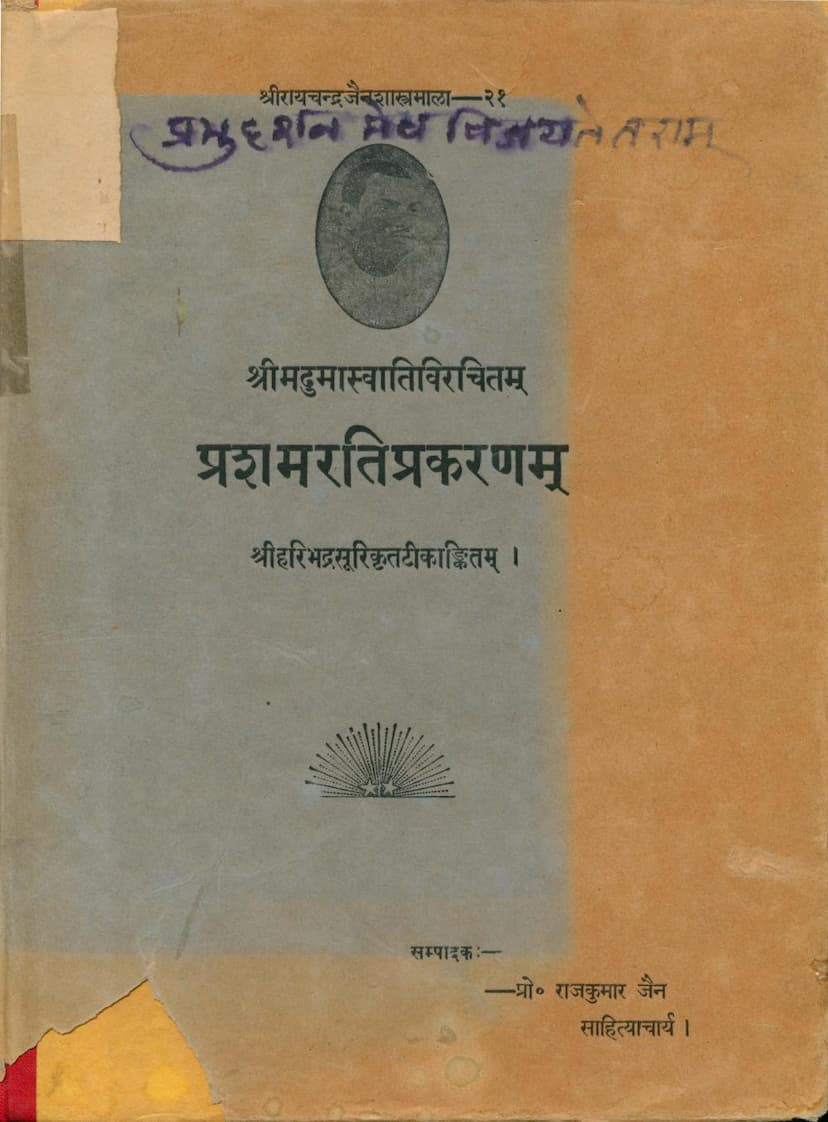Prashamrati Prakaranam
Added to library: September 2, 2025

Summary
This is a comprehensive summary of the Jain text "Prashamrati Prakaranam" by Acharya Umāsvāti, with a commentary by Acharya Haribhadrasūri, as presented in the provided Sanskrit and Hindi text. The summary is structured around the book's contents and the publisher's notes.
Book Title: Prashamrati Prakaranam (प्रशमरति प्रकरणम्) Author: Acharya Umāsvāti (श्रीमदुमास्वातिविरचितम्) Commentary Author: Acharya Haribhadrasūri (श्रीहरिभद्रसूरिकृतटीकाङ्कितम्) Editor: Prof. Rajkumar Jain (सम्पादक:-प्रो. राजकुमार जैन) Publisher: Shri Paramshrut Prabhavak Mandal (प्रकाशक: श्रीपरमश्रुतप्रभावक मंडल) Published: Shri Veer Nirvana Samvat 2476 / Vikram Samvat 2007 (1950 AD)
Overall Theme: The "Prashamrati Prakaranam" is a Jain text that focuses on cultivating inner peace (Prasham) and detachment (Vairagya). It aims to guide individuals towards spiritual liberation by detailing the causes of suffering and the path to overcome them, emphasizing the importance of proper conduct (Achar), contemplation (Bhavana), and devotion (Dharma).
Key Sections and Concepts:
The book is divided into ten chapters (Adhikaras), each delving into specific aspects of Jain philosophy and practice:
- Chapter 1: Pitthbandha (पीठबन्ध): Discusses the initial binding of the soul with karma.
- Chapter 2: Kashaya (कषाय): Explains the nature and impact of anger, pride, deceit, and greed, detailing their destructive effects on the soul.
- Chapter 3: Raga-dvesha Bandha (रागादि-बन्ध): Explores the eight types of bondage caused by attachment and aversion.
- Chapter 4: Ashtakarma Bandha (आठ कर्म-बन्ध): Details the eight karmas and their causes and effects.
- Chapter 5: Panch-Indriya Vishaya (पंचेन्द्रिय विषय): Examines the five senses and their objects, illustrating with examples (like the deer, bee, fish, elephant) how attachment to sensory pleasures leads to downfall. It highlights that no sensory object provides lasting satisfaction and even pleasant experiences can turn unpleasant.
- Chapter 6: Ashtamada (आठ मद): Addresses the eight types of arrogance or pride (related to birth, form, strength, wealth, knowledge, modesty, penance, and renunciation) and their detrimental effects, counseling against them.
- Chapter 7: Achar (आचार): Focuses on righteous conduct, explaining its importance, classification (fivefold), and illustrating virtues like humility and discipline through various examples and scriptural references (like from Acharanga Sutra). It stresses the significance of adhering to ethical principles.
- Chapter 8: Bhavana (भावना): Discusses the twelve important contemplations (Bhavanas) such as impermanence (Anityabhavana), helplessness (Asharanabhavana), oneness (Ekattva), impurity (Ashuchitva), the cycle of existence (Samsara), the influx of karma (Asrava), the cessation of influx (Samvara), the shedding of karma (Nirjara), the nature of the world (Loka), the rarity of right faith (Durlabhbodhi), and the importance of studying the scriptures (Shastra). These Bhavanas are crucial for developing detachment.
- Chapter 9: Dharma (धर्म): Explains the ten cardinal virtues of Jainism: forgiveness (Kshama), humility (Mardava), honesty (Arjava), purity (Shaucha), truthfulness (Satya), restraint (Samvara), penance (Tapas), non-possession (Akinchanya), chastity (Brahmacharya), and detachment (Tyaga).
- Chapter 10: Dharma-Katha (धर्म-कथा): Describes the four types of religious discourse: Acupunctural (Akshapaṇī - attracting the listener), Distracting (Vikshepaṇī - turning away from worldly desires), Consoling (Samvedani - providing comfort and assurance), and Detaching (Nivedani - creating aversion to worldly things). It also warns against four types of undesirable talk: gossip (Chorakatha), sensual talk (Strī-katha), self-praise (Ātmakathā), and regional talk (Deśakathā).
Publisher's Note: The publisher, Shri Paramshrut Prabhavak Mandal, highlights that this is the second work of Acharya Umāsvāti to be published by their "Rayachandra Jain Shastra Mala" series, following his famous "Sāṣaṭa Tattvārthādhigama Sūtra" (Moksha Shastra). They note the book's acceptance in both Digambara and Shvetambara traditions, with a reference from Dhaval commentary. The publication includes the ancient Sanskrit commentary by Acharya Haribhadrasūri and a Hindi translation. They express gratitude to Prof. Kailashchandra Shastri for starting the translation and Prof. Rajkumar Jain for completing it, commending their diligent work in editing the original text and commentary. A detailed introduction by Prof. Rajkumar Jain was also mentioned as forthcoming.
Key Philosophical Underpinnings:
- Karma Theory: The text heavily relies on the Jain understanding of karma, detailing how actions driven by passions (Kashayas) and sensory attachments lead to karmic bondage, perpetuating the cycle of birth and death (Samsara).
- Detachment (Vairagya/Prasham): The core message is the cultivation of detachment from worldly pleasures and passions to achieve inner peace and ultimately liberation.
- Self-Control (Samvara) and Austerity (Tapas): The text emphasizes the necessity of controlling the senses and mind, along with engaging in austerities, as a means to shed accumulated karma (Nirjara).
- Right Faith, Knowledge, and Conduct (Trikaran Shuddhi): The ultimate goal is to achieve liberation through the purification of mind, speech, and body, guided by right faith (Samyakdarshan), right knowledge (Samyakgyan), and right conduct (Samyakcharitra).
- Ahimsa (Non-violence): Underlying all conduct is the principle of Ahimsa, extending compassion to all living beings.
Summary of Core Teachings:
The "Prashamrati Prakaranam" serves as a guide to understanding the spiritual path within Jainism. It systematically outlines the obstacles created by sensory attachments, passions, and arrogance, and provides practical guidance on overcoming them through ethical conduct, scriptural study, virtuous contemplation, and unwavering devotion. The text uses vivid examples and analogies to illustrate the impermanence of worldly happiness and the ultimate bliss derived from inner peace and spiritual liberation. It underscores that true happiness lies not in external possessions or sensory gratification but in the purification of the soul and its liberation from the cycle of birth and death. The importance of the teachings of the Tirthankaras and the guidance of spiritual preceptors is also highlighted.